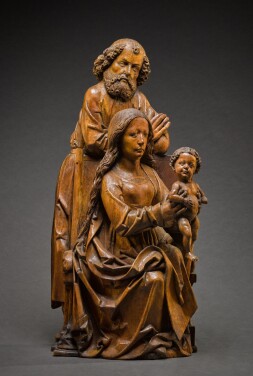No artistic medium has shaped European civilisation as profoundly as sculpture. From the stone gods and rulers of antiquity, to their discovery and influence in later centuries, this exciting sale seeks to present thought-provoking dialogues between three-dimensional art across the ages. Spanning four millennia, these diverse works of art reveal fascinating links through a common use of techniques and materials, an impulse to depict the human form and countenance, the embodiment of the divine, or the unification of form and function.
Watch our video on the sale below
BC / AD – Sculpture Spanning Four Millennia


With its three-dimensional occupation of space, sculpture has long been a powerful tool in the affirmation of belief. In antiquity, statues of the Pagan deities were ubiquitous, reminding the viewer of all aspects of life. Appearing in the form of a satyr bearing fruit, Pan (lot 40), the god of the wild, nature, and abandonment, seems here to engage with an unseen interlocutor. Sculpture in the Middle Ages focused on the promotion of Christianity in ecclesiastical settings. The Virgin and Child (lot 77) became an iconic image of veneration in Gothic art, and by the early 16th century, pioneering sculptors such as Tilman Riemenschneider (lot 9) used highly expressive modes of representation to make the sacred seem real.

The flexibility, durability and strength of bronze have been appreciated by artists for thousands of years. As such, bronze as a sculptural material forms an unbroken tradition from Ancient Egypt to the modern day. This is wonderfully demonstrated in our sale with sculptures from the seated Egyptian Cat (lot 64), used as a votive offering, and the gilt bronze fragment of an Arm from Imperial Rome (lot 44), to the Baroque drama of Algardi’s Cristo Vivo (lot 125) and the tactile maquette of a woman sewing by Aimé-Jules Dalou (lot 160).
What unites these disparate bronzes is the ‘lost wax’ process of casting in which the sculptor’s work is modelled or cast in wax before being encased in a mould of plaster and heated so the wax can be poured out and the molten bronze poured in. Once cooled and released from the mould, the bronze perfectly reproduces the wax original and can then be chased to add more details, before adding a patina.

Since pre-historic times, sculptors have been occupied with the representation of the human form. The present sale charts a history of the body in sculpture, from the stylised sensuality of Egyptian and archaic Greek figures (lots 56 and 17), to the idealised nudes of classical Greece and Rome, which so inspired neoclassical sculptors in the 18th and 19th centuries. The Victorian reactions to John Gibson’s Tinted Venus (lot 5), derived from ancient statues of Aphrodite (lot 6), are a testament to the sculpted body’s timeless potential to both shock and beguile.


While sculpture is often associated with figural depictions, many objects that might be considered utilitarian cross the boundary into fine art due to their masterful artistry. This sale offers examples of such in the form of a newly discovered astrolabe by Gualterus Arsenius (lot 7), a beautiful enamelled dish from 16-century Limoges, and a small Roman Marble Feline Paw (lot 53) that once stood at the foot of an ancient table.

The individual depiction of the human countenance has been a fascination of mankind since its inception. Portraiture is a particularly potent sub-genre of sculpture given its ability to provide glimpses of the human psyche through the rendering of physical appearances. This sale includes portraits of a wide array of individuals ranging from a granite figure of Pakhom, an Egyptian governor who lived during the time of Cleopatra (lot 60), to a marble bust by Prosper D’Epinay depicting the early American socialite and heiress, Athenais Grymes (lot 156).
In the past the beard was more than a male fashion accessory. In ancient Greece it was seen as a mark of virility, and Roman Emperors from Hadrian to Constantine were bearded. Lot 49 shows a particularly fine example of how the beard was worn in the 2nd century AD during the reign of Antoninus Pius, which is neatly contrasted with the impressive beard worn by the 19th century Neapolitan painter, Domenico Morelli, in Gemito’s bronze portrait (lot 169).































